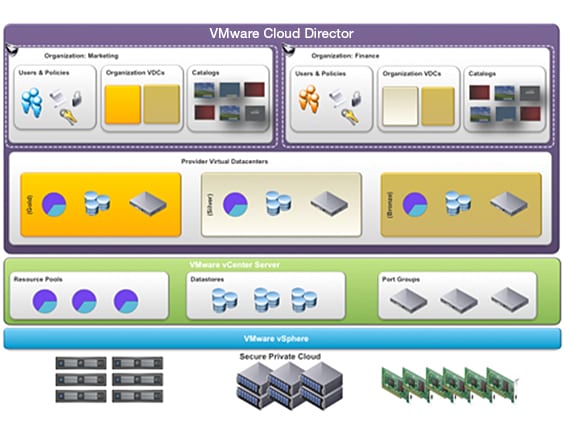If you are setting up a public cloud or a large-scale private cloud infrastructure, you will probably evaluate VMware Cloud Director, VMware’s proven, robust solution for building large-scale cloud systems.
VMware Cloud is a large and complex platform—in this article, we can provide a brief overview of its basic structure and concepts. In addition, we’ll show how you can easily manage huge VMware storage volumes using Cloudian’s VMware-certified, exabyte-scale object storage solution.
In this article you will learn:
- What is VMware Cloud Director?
- vCloud Director Concepts
- Key features
- Elastic Object Storage for VMware Cloud Director
This article is part of a series on VMware Storage.
What is VMware Cloud Director?
VMware Cloud Director is a VMware platform that powers public cloud services. It turns a physical data center, or multiple data centers distributed across different geographical locations, into Virtual Data Centers (VDC). Within these VDCs, VMware Cloud Director allows elastic provisioning of network, storage and compute resources, and lets cloud providers define services and offer them to users via a service catalog.

Source: VMware
VMware Cloud Director provides the following benefits for cloud providers:
- Improves resource utilization in data centers and reduces operational overheads
- Makes it easy to monetize services by publishing a service suite with integrated billing
- All-in-one solution for building a public cloud with no additional tools or costs
- API-based approach to enable easy automation and customizability for users
VMware Cloud Director Concepts
The VMware Cloud Director is based on the following concepts:
- Organizations—a unit of administration for users, groups, and computing resources. Authentication of users is managed is at the organization level. VMware Cloud Director system administrators can create and provision organizations, and organization administrators users, groups, and service catalogs.
- Users and groups—administrators can create users manually or programmatically, or integrate with a directory service like LDAP to import user accounts and user groups at scale.
- Virtual Data Centers (VDC)—a VDC is an isolated environment provided to a cloud user, in which they can provision resources, deploy, store and operate applications and systems.
- Organization VMware Cloud Director Networks—similar to the Amazon concept of Virtual Private Cloud, a VMware Cloud Director network is available only to a specific VMware Cloud Director and available to all vApps in the organization. It can be connected to external networks as needed.
- vApp Networks—similar to the concept of a subnet, a vApp network is an isolated network within a VMware Cloud Director network that allows specific vApps to communicate with each other.
- vApp—one or more virtual machines that come preconfigured with applications and configuration to provide a specific type of cloud service. vApps can include several virtual machines, working together as a unified application stack.
- Media files and catalogs—VMware Cloud Director organizes deployable resources via media files. These are virtual machine and vApp templates, or machine images that can be used as boot-up disks for a VM. Media files can be attached to vApps and mounted by virtual machines. The organization administrator organizes media files into catalogs, allowing users within the organization to provision the resources they need.
Key Features of VMware Cloud Director
While VMware Cloud Director is a large and extremely complex offering, below we summarize some of its main capabilities.
| Capability | Primarily Used By | Details |
| Multi-tenancy | Cloud operators | Uses bare-metal machines to create a pool of resources that can host and serve many customers, each with complete isolation. All tenants are centrally managed from a single vCenter interface. |
| Service suite and third-party offerings | Cloud operators | Allows cloud providers to publish their own services or use pre-integrated software from other vendors for data protection, networking, security, etc. |
| Global hybrid cloud management | Cloud operators | Manages and monitors multiple heterogenous data centers, with central control from a single interface. Can scale up to thousands of sites. |
| Resource migration between VCDs | Cloud operators | Makes it easy to perform cold or warm migrations of resources between data centers, with data protection capabilities compatible with customer’s local enterprise environment. |
| API-driven automation | Cloud users | Offers developer-friendly APIs, letting users to programmatically control every aspect of their cloud infrastructure using an Infrastructure as Code paradigm. |
| Policy-driven management | Cloud operators and cloud users | Gives each user an isolated environment with independent role-based authentication and access control to their resources, and provides the cloud operator with an access control hierarchy across VCDs, sites, virtual machines, and applications. |
Read more in our guides on VMware Backup and VMware Site Recovery Manager.
Cloudian HyperStore: Elastic Object Storage for VMware Cloud Director
Cloudian Object Storage for VMware Cloud Director is an integrated VMware storage platform that deploys and manages Exabyte-scale object storage pools. It can be used to set up an S3-compatible cloud storage service within Virtual Data Centers. Cloudian allows administrators to provision storage pools directly from the vCenter interface, without interacting directly with storage infrastructure.Cloudian uses the de-facto storage interface of the public cloud, the S3 API, making VMware Cloud Director VCDs compatible with existing cloud deployments and easy to migrate from popular cloud providers.
Key features of Cloudian Object Storage for VMware Cloud Director:
- Multi-tenant Resource Pooling—independent role-based authentication to virtual storage resources
- Geo-Distribution—simple tools for migrating storage between storage pools deployed in different geographical regions
- Integrated Management—management of storage functions with granular control across users and groups, through the vCenter interface or user APIs.
- Quality of Service—centrally manage SLAs including throughput and bandwidth controls.
- Billing—automatically generate client billing information.
- Data Durability—protects data with up to 14 nines (99.999999999999%) durability.
- Self-service Management—allows users to self-provision storage resources using role-based access.
